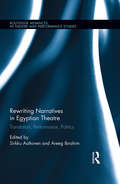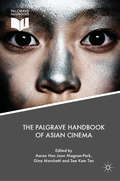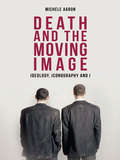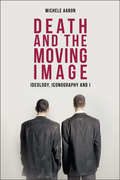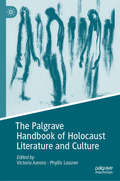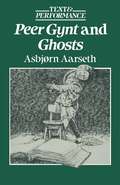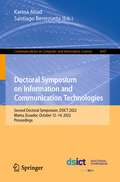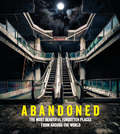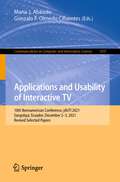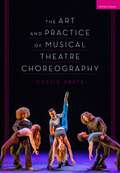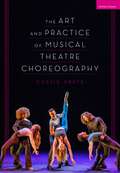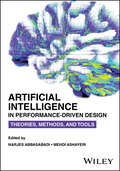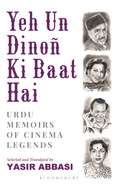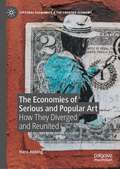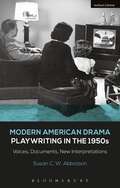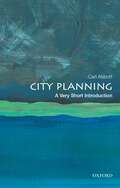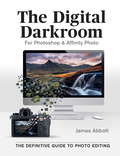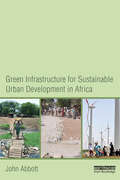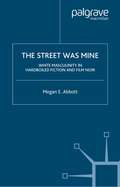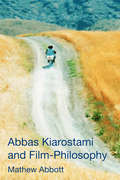- Table View
- List View
Rewriting Narratives in Egyptian Theatre: Translation, Performance, Politics (Routledge Advances in Theatre & Performance Studies)
by Sirkku Aaltonen Areeg IbrahimThis study of Egyptian theatre and its narrative construction explores the ways representations of Egypt are created of and within theatrical means, from the 19th century to the present day. Essays address the narratives that structure theatrical, textual, and performative representations and the ways the rewriting process has varied in different contexts and at different times. Drawing on concepts from Theatre and Performance Studies, Translation Studies, Cultural Studies, Postcolonial Studies, and Diaspora Studies, scholars and practitioners from Egypt and the West enter into dialogue with one another, expanding understanding of the different fields. The articles focus on the ways theatre texts and performances change (are rewritten) when crossing borders between different worlds. The concept of rewriting is seen to include translation, transformation, and reconstruction, and the different borders may be cultural and national, between languages and dramaturgies, or borders that are present in people’s everyday lives. Essays consider how rewritings and performances cross borders from one culture, nation, country, and language to another. They also study the process of rewriting, the resulting representations of foreign plays on stage, and representations of the Egyptian revolution on stage and in Tahrir Square. This assessment of the relationship between theatre practices, exchanges, and rewritings in Egyptian theatre brings vital coverage to an undervisited area and will be of interest to developments in theatre translation and beyond.
Rewriting Narratives in Egyptian Theatre: Translation, Performance, Politics (Routledge Advances in Theatre & Performance Studies)
by Sirkku Aaltonen Areeg IbrahimThis study of Egyptian theatre and its narrative construction explores the ways representations of Egypt are created of and within theatrical means, from the 19th century to the present day. Essays address the narratives that structure theatrical, textual, and performative representations and the ways the rewriting process has varied in different contexts and at different times. Drawing on concepts from Theatre and Performance Studies, Translation Studies, Cultural Studies, Postcolonial Studies, and Diaspora Studies, scholars and practitioners from Egypt and the West enter into dialogue with one another, expanding understanding of the different fields. The articles focus on the ways theatre texts and performances change (are rewritten) when crossing borders between different worlds. The concept of rewriting is seen to include translation, transformation, and reconstruction, and the different borders may be cultural and national, between languages and dramaturgies, or borders that are present in people’s everyday lives. Essays consider how rewritings and performances cross borders from one culture, nation, country, and language to another. They also study the process of rewriting, the resulting representations of foreign plays on stage, and representations of the Egyptian revolution on stage and in Tahrir Square. This assessment of the relationship between theatre practices, exchanges, and rewritings in Egyptian theatre brings vital coverage to an undervisited area and will be of interest to developments in theatre translation and beyond.
The Palgrave Handbook of Asian Cinema
by Aaron Han Joon Magnan-Park Gina Marchetti See Kam TanThis collection offers new approaches to theorizing Asian film in relation to the history, culture, geopolitics and economics of the continent. Bringing together original essays written by established and emerging scholars, this anthology transcends the limitations of national borders to do justice to the diverse ways in which the cinema shapes Asia geographically and imaginatively in the world today. From the revival of the Silk Road as the “belt and road” of a rising China to historical ruminations on the legacy of colonialism across the continent, the authors argue that the category of “Asian cinema” from Turkey to the edges of the Pacific continues to play a vital role in cutting-edge film research. This handbook will serve as an essential guide for committed scholars, students, and all those interested in the past, present, and possible future of Asian cinema in the 21st century.
Death and the Moving Image: Ideology, Iconography and I
by Michele AaronDeath and the Moving Image examines the representation of death and dying in mainstream cinema from its earliest to its latest renditions to reveal the ambivalent place of death in twentieth and twenty-first century culture: the ongoing split between its over- and under-statement, between its cold, bodily, realities and its fantastical, transcendental and, most importantly, strategic depictions. Our screens are steeped in death’s dramatics: in spectacles of glorious sacrifice or bloody retribution, in the ecstasy of agony, but always in the promise of redemption. This book is about the staging of these dramatics in mainstream Western film and the discrepancies that fuel them and are, by return, fuelled by them. Exploring the impact of gender, race, nation or narration upon them, this groundbreaking study isolates how mainstream cinema works to bestow value upon certain lives, and specific socio-cultural identities, in a hierarchical and partisan way. Dedicated to the popular, to the political and ethical implications of mass culture’s themes and imperatives, Death and the Moving Image takes this culture to task for its mortal economies of expendability. Ultimately, it also disinters the capacity for film, and film criticism, to engage with life and vulnerability differently and even generatively.
Death and the Moving Image: Ideology, Iconography and I
by Michele AaronDeath and the Moving Image examines the representation of death and dying in mainstream cinema from its earliest to its latest renditions to reveal the ambivalent place of death in twentieth and twenty-first century culture: the ongoing split between its over- and under-statement, between its cold, bodily, realities and its fantastical, transcendental and, most importantly, strategic depictions. Our screens are steeped in death’s dramatics: in spectacles of glorious sacrifice or bloody retribution, in the ecstasy of agony, but always in the promise of redemption. This book is about the staging of these dramatics in mainstream Western film and the discrepancies that fuel them and are, by return, fuelled by them. Exploring the impact of gender, race, nation or narration upon them, this groundbreaking study isolates how mainstream cinema works to bestow value upon certain lives, and specific socio-cultural identities, in a hierarchical and partisan way. Dedicated to the popular, to the political and ethical implications of mass culture’s themes and imperatives, Death and the Moving Image takes this culture to task for its mortal economies of expendability. Ultimately, it also disinters the capacity for film, and film criticism, to engage with life and vulnerability differently and even generatively.
The Palgrave Handbook of Holocaust Literature and Culture
by Victoria Aarons Phyllis LassnerThe Palgrave Handbook of Holocaust Literature and Culture reflects current approaches to Holocaust literature that open up future thinking on Holocaust representation. The chapters consider diverse generational perspectives—survivor writing, second and third generation—and genres—memoirs, poetry, novels, graphic narratives, films, video-testimonies, and other forms of literary and cultural expression. In turn, these perspectives create interactions among generations, genres, temporalities, and cultural contexts. The volume also participates in the ongoing project of responding to and talking through moments of rupture and incompletion that represent an opportunity to contribute to the making of meaning through the continuation of narratives of the past. As such, the chapters in this volume pose options for reading Holocaust texts, offering openings for further discussion and exploration. The inquiring body of interpretive scholarship responding to the Shoah becomes itself a story, a narrative that materially extends our inquiry into that history.
Peer Gynt and Ghosts: Text and Performance (Text and Performance)
by Asbjorn AarsethA study of two of Henrik Ibsen's most impressive and frequently- performed dramatic texts, the dramatic poem Peer Gynt and the concentrated prose play Ghosts, whose appearance caused an uproar when first performed. In the first half of the book, the author pays particular attention to the imagery patterns of Ibsen's language; Peer Gynt is considered in its cultural context, and Ghosts with reference to Ibsen's concept of drama. Recent productions of both plays are considered in detail, including the Young Vic production of Ghosts in 1986.
Doctoral Symposium on Information and Communication Technologies: Second Doctoral Symposium, DSICT 2022, Manta, Ecuador, October 12–14, 2022, Proceedings (Communications in Computer and Information Science #1647)
by Karina Abad Santiago BerrezuetaThis book constitutes the refereed proceedings of the Second Doctoral Symposium on Information and Communication Technologies, DSICT 2022, held in Manta, Ecuador, in October 2022. The 15 full papers were thoroughly reviewed and selected from the 72 submissions. The papers present research in areas of intelligent systems, artificial intelligence, ICTs and their applications to the real world.
Abandoned: The most beautiful and forgotten places from around the world
by AbandonedThe places time forgotFrom the magical empty theatres of Detroit to the lost playgrounds of Chernobyl, there are places across the globe that were once a hub of activity, but are now abandoned and in decay. With nature creeping in and reclaiming these spots, we are left with eerie crumbling ruins and breathtaking views that offer us a window into the past and capture our imagination. Abandoned showcases the very best photographs from around the world documenting this phenomenon.More immersive than a museum and more human that a lecture, abandoned photography has given the world an exciting way to look at our history and the places we have long neglected.Compiled and curated by photographer and former urban explorer, Mathew Growcoot.
Applications and Usability of Interactive TV: 10th Iberoamerican Conference, jAUTI 2021, Sangolquí, Ecuador, December 2–3, 2021, Revised Selected Papers (Communications in Computer and Information Science #1597)
by María J. Abásolo Gonzalo F. Olmedo CifuentesThis book constitutes thoroughly refereed and revised selected papers from the 10th Iberoamerican Conference on Applications and Usability of Interactive TV, jAUTI 2021, held in Sangolqui, Ecuador, during December 2–3, 2021.The 9 full papers included in this book were carefully reviewed and selected from 25 submissions. They were organized in topical sections as follows: Usability and UX; interaction techniques and accesibility; and technologies, services, and applications for interactive digital TV.
The Art and Practice of Musical Theatre Choreography
by Cassie AbateWhat does a musical theatre choreographer actually do? They just 'make up the steps', right? This book firstly debunks the misunderstandings around what musical theatre choreographers actually do, demonstrating their need to have an in-depth understanding of storytelling, music theory, performance practices and plot structure in order to create movement that enhances and enlivens the musical. Secondly, it equips the musical theatre choreographer with all the tools needed to create nuanced, informed and inspired movement for productions, through structured activities that build specific skills (such as 'notating the script' and 'scoring the score').Traditionally, this training has been something of a series of secrets, passed from mentor to apprentice. The author demystifies the process to make the previously undisclosed “tricks of the trade” accessible to all choreographers, everywhere. Covering the entire process of choreographing a musical from the first script reading to the final curtain call, this book makea case for the absolute integrity of the choreographer to any musical theatre production and sets out the theoretical principles of choreography alongside the practical application during every step of the production process.
The Art and Practice of Musical Theatre Choreography
by Cassie AbateWhat does a musical theatre choreographer actually do? They just 'make up the steps', right? This book firstly debunks the misunderstandings around what musical theatre choreographers actually do, demonstrating their need to have an in-depth understanding of storytelling, music theory, performance practices and plot structure in order to create movement that enhances and enlivens the musical. Secondly, it equips the musical theatre choreographer with all the tools needed to create nuanced, informed and inspired movement for productions, through structured activities that build specific skills (such as 'notating the script' and 'scoring the score').Traditionally, this training has been something of a series of secrets, passed from mentor to apprentice. The author demystifies the process to make the previously undisclosed “tricks of the trade” accessible to all choreographers, everywhere. Covering the entire process of choreographing a musical from the first script reading to the final curtain call, this book makea case for the absolute integrity of the choreographer to any musical theatre production and sets out the theoretical principles of choreography alongside the practical application during every step of the production process.
Artificial Intelligence in Performance-Driven Design: Theories, Methods, and Tools
by Narjes Abbasabadi Mehdi AshayeriARTIFICIAL INTELLIGENCE IN PERFORMANCE-DRIVEN DESIGN A definitive, interdisciplinary reference to using artificial intelligence technology and data-driven methodologies for sustainable design Artificial Intelligence in Performance-Driven Design: Theories, Methods, and Tools explores the application of artificial intelligence (AI), specifically machine learning (ML), for performance modeling within the built environment. This work develops the theoretical foundations and methodological frameworks for utilizing AI/ML, with an emphasis on multi-scale modeling encompassing energy flows, environmental quality, and human systems. The book examines relevant practices, case studies, and computational tools that harness AI’s capabilities in modeling frameworks, enhancing the efficiency, accuracy, and integration of physics-based simulation, optimization, and automation processes. Furthermore, it highlights the integration of intelligent systems and digital twins throughout the lifecycle of the built environment, to enhance our understanding and management of these complex environments. This book also: Incorporates emerging technologies into practical ideas to improve performance analysis and sustainable design Presents data-driven methodologies and technologies that integrate into modeling and design platforms Shares valuable insights and tools for developing decarbonization pathways in urban buildings Includes contributions from expert researchers and educators across a range of related fields Artificial Intelligence in Performance-Driven Design is ideal for architects, engineers, planners, and researchers involved in sustainable design and the built environment. It’s also of interest to students of architecture, building science and technology, urban design and planning, environmental engineering, and computer science and engineering.
Yeh Un Dinoñ Ki Baat Hai: Urdu Memoirs of Cinema Legends
by Yasir AbbasiPeppered with heartfelt accounts and charming anecdotes, Urdu film magazines were in great favour with the public from the 1930s through the 1990s – a considerable period of seven decades. As Urdu got progressively marginalised in the later years, unfortunately these magazines were not archived for the most part, leading to their inevitable disappearance from popular imagination. Tracking down the lost publications, Yasir Abbasi followed leads – some futile, some fruitful – to obscure towns and people's homes in a last-ditch effort to save valuable records of Indian cinema. As challenging as it was to locate the faded issues and original texts, he managed to uncover and translate many fabulous memoirs covering a wide gamut of our favourite old artistes at their candid best. A gloom-laced piece on Meena Kumari by Nargis, a rollicking description by Raja Mehdi Ali Khan of an eventful evening with Manto (not to mention a mysterious woman and a house on fire), Jaidev writing about his chequered career, Balraj Sahni introspecting about the relevance of Hindi and Urdu in films – it's a rich mix of engrossing narratives brought back from oblivion.
The Economies of Serious and Popular Art: How They Diverged and Reunited (Cultural Economics & the Creative Economy)
by Hans AbbingCombining an economic perspective with sociological and historic insights, this book investigates the separation of ‘popular’ and ‘serious’ art over a period of almost two centuries. As the boundaries between our perceptions of established art and popular become more porous, Abbing considers questions such as: Who benefitted from the separation? Why is exclusivity in the established arts so important? Did exclusivity lead to high cost, high subsidies and high prices? Were and are underprivileged groups excluded from art consumption and production? How did popular music become so successful in the second half of the twentieth century? Why does the art profession remain extraordinarily attractive for youngsters in spite of low incomes? The book also discusses the evolution of art in the twenty-first century, considering for example how the platform economy affects the arts, whether or not the established arts are joining the entertainment industry, and the current level of diversity in art. Written from the dual perspective of the author as an artist and social scientist, the book will be of interest for cultural economists and academics as well as artists and general readers interested in art.
Modern American Drama: Voices, Documents, New Interpretations (Decades of Modern American Drama: Playwriting from the 1930s to 2009)
by Susan C. AbbotsonThe Decades of Modern American Drama series provides a comprehensive survey and study of the theatre produced in each decade from the 1930s to 2009 in eight volumes. Each volume equips readers with a detailed understanding of the context from which work emerged: an introduction considers life in the decade with a focus on domestic life and conditions, social changes, culture, media, technology, industry and political events; while a chapter on the theatre of the decade offers a wide-ranging and thorough survey of theatres, companies, dramatists, new movements and developments in response to the economic and political conditions of the day. The work of the four most prominent playwrights from the decade receives in-depth analysis and re-evaluation by a team of experts, together with commentary on their subsequent work and legacy. A final section brings together original documents such as interviews with the playwrights and with directors, drafts of play scenes, and other previously unpublished material.The major writers and their works to receive in-depth coverage in this volume include:* William Inge: Picnic (1953), Bus Stop (1955) and The Dark at the Top of the Stairs (1957);* Stephen Sondheim, Arthur Laurents and Jerome Robbins: West Side Story (1957) and Gypsy (1959); * Alice Childress: Just a Little Simple (1950), Gold Through the Trees (1952) and Trouble in Mind (1955);* Jerome Lawrence and Robert Lee: Inherit the Wind (1955), Auntie Mame (1956) and The Gang's All Here (1959).
Modern American Drama: Voices, Documents, New Interpretations (Decades of Modern American Drama: Playwriting from the 1930s to 2009)
by Susan C. AbbotsonThe Decades of Modern American Drama series provides a comprehensive survey and study of the theatre produced in each decade from the 1930s to 2009 in eight volumes. Each volume equips readers with a detailed understanding of the context from which work emerged: an introduction considers life in the decade with a focus on domestic life and conditions, social changes, culture, media, technology, industry and political events; while a chapter on the theatre of the decade offers a wide-ranging and thorough survey of theatres, companies, dramatists, new movements and developments in response to the economic and political conditions of the day. The work of the four most prominent playwrights from the decade receives in-depth analysis and re-evaluation by a team of experts, together with commentary on their subsequent work and legacy. A final section brings together original documents such as interviews with the playwrights and with directors, drafts of play scenes, and other previously unpublished material.The major writers and their works to receive in-depth coverage in this volume include:* William Inge: Picnic (1953), Bus Stop (1955) and The Dark at the Top of the Stairs (1957);* Stephen Sondheim, Arthur Laurents and Jerome Robbins: West Side Story (1957) and Gypsy (1959); * Alice Childress: Just a Little Simple (1950), Gold Through the Trees (1952) and Trouble in Mind (1955);* Jerome Lawrence and Robert Lee: Inherit the Wind (1955), Auntie Mame (1956) and The Gang's All Here (1959).
City Planning: A Very Short Introduction (Very Short Introductions)
by Carl AbbottCity planning is a practice and a profession. It is also a set of goals and--sometimes utopian--aspirations. Formal thought about the shaping of cities as physical spaces and social environments calls on the same range of disciplines and approaches that we use for understanding cities themselves, from art and literature through the social and natural sciences. Surrounding the core profession of city planning, also known as urban or town planning, are related fields of architecture, landscape design, engineering, geography, political science and policy, sociology, and social work. In addition, the legions of community and environmental activists influence debates and controversies within the field. This Very Short Introduction is organized around eight key aspects of city planning: street layout; congestion and decentralization; the response to suburbanization; the conservation and regeneration of older districts; cities as natural systems; cities and regions; social class and ethnicity; and disasters and resilience. The underlying assumption throughout is that decisions that we make today about cities and metropolitan regions are best understood as the continuation of past efforts to solve fundamental problems that have shifted and evolved over multiple generations. At its best, city planning utilizes technical tools to achieve goals set by community action and political debate. Carl Abbott's addition to Oxford's long-running Very Short Introduction series is a brief but concentrated look at past decisions about the management of urban growth and their effects on the creation of the twenty-first century city. ABOUT THE SERIES: The Very Short Introductions series from Oxford University Press contains hundreds of titles in almost every subject area. These pocket-sized books are the perfect way to get ahead in a new subject quickly. Our expert authors combine facts, analysis, perspective, new ideas, and enthusiasm to make interesting and challenging topics highly readable.
City Planning: A Very Short Introduction (Very Short Introductions)
by Carl AbbottCity planning is a practice and a profession. It is also a set of goals and--sometimes utopian--aspirations. Formal thought about the shaping of cities as physical spaces and social environments calls on the same range of disciplines and approaches that we use for understanding cities themselves, from art and literature through the social and natural sciences. Surrounding the core profession of city planning, also known as urban or town planning, are related fields of architecture, landscape design, engineering, geography, political science and policy, sociology, and social work. In addition, the legions of community and environmental activists influence debates and controversies within the field. This Very Short Introduction is organized around eight key aspects of city planning: street layout; congestion and decentralization; the response to suburbanization; the conservation and regeneration of older districts; cities as natural systems; cities and regions; social class and ethnicity; and disasters and resilience. The underlying assumption throughout is that decisions that we make today about cities and metropolitan regions are best understood as the continuation of past efforts to solve fundamental problems that have shifted and evolved over multiple generations. At its best, city planning utilizes technical tools to achieve goals set by community action and political debate. Carl Abbott's addition to Oxford's long-running Very Short Introduction series is a brief but concentrated look at past decisions about the management of urban growth and their effects on the creation of the twenty-first century city. ABOUT THE SERIES: The Very Short Introductions series from Oxford University Press contains hundreds of titles in almost every subject area. These pocket-sized books are the perfect way to get ahead in a new subject quickly. Our expert authors combine facts, analysis, perspective, new ideas, and enthusiasm to make interesting and challenging topics highly readable.
The Digital Darkroom: The Definitive Guide to Photo Editing
by James AbbottPost-production can make the difference between a good image and a great image, not to mention it's an essential process if you shoot in RAW to enjoy the most flexibility and control possible. This book will outline everything you need to know to gain a better understanding of how to apply darkroom style effects to your images using Adobe Photoshop and Affinity Photo.Through detailed background knowledge designed to make you familiar with the software and to build your confidence, you'll learn a wide range of skills and techniques through step-by-step case studies that will make learning an active experience. Not only will this be a valuable reference resource, it will also be your very own personal tutor giving you everything you need to edit your images like a pro. - Learn the essentials with a complete guide to every tool, filter and effect for both Adobe Photoshop and Affinity Photo- Get the most out of your RAW files with detailed instructions on processing your digital image- Master basic, intermediate, and advanced editing techniques with easy to follow step-by-step tutorials- Get the best quality images for display with a complete guide to home printing
Green Infrastructure for Sustainable Urban Development in Africa
by John AbbottThis book shows for the first time how green infrastructure can work in an African urban context. On one level it provides a major rethinking of the role of infrastructure in urban society since the creation of networked infrastructure in the early twentieth century. On another, it explores the changing paradigms of urban development through the fundamental question of how decisions are made. With a focus on Africa's fast-growing secondary towns, where 70 per cent of the urban population live, the book explains how urban infrastructure provides the key to the relationship between economic development and social equity, through the mediation of natural resources. Adopting this view enables investment to be channelled more effectively to provide the engine for economic growth, while providing equitable services for all residents. At the same time, the mediation of resource flows integrates the metabolism of the city into the wider ecosystem. This vision leads to a new way of thinking about infrastructure, giving clear definition to the concept of green infrastructure. On the basis of research gathered throughout an extensive career, John Abbott draws in particular from his experience in Ethiopia to demonstrate the ways in which infrastructure needs to respond to the economies, societies and natural environments of twenty-first century urban Africa.
Green Infrastructure for Sustainable Urban Development in Africa
by John AbbottThis book shows for the first time how green infrastructure can work in an African urban context. On one level it provides a major rethinking of the role of infrastructure in urban society since the creation of networked infrastructure in the early twentieth century. On another, it explores the changing paradigms of urban development through the fundamental question of how decisions are made. With a focus on Africa's fast-growing secondary towns, where 70 per cent of the urban population live, the book explains how urban infrastructure provides the key to the relationship between economic development and social equity, through the mediation of natural resources. Adopting this view enables investment to be channelled more effectively to provide the engine for economic growth, while providing equitable services for all residents. At the same time, the mediation of resource flows integrates the metabolism of the city into the wider ecosystem. This vision leads to a new way of thinking about infrastructure, giving clear definition to the concept of green infrastructure. On the basis of research gathered throughout an extensive career, John Abbott draws in particular from his experience in Ethiopia to demonstrate the ways in which infrastructure needs to respond to the economies, societies and natural environments of twenty-first century urban Africa.
The Street Was Mine: White Masculinity in Hardboiled Fiction and Film Noir
by M. AbbottThis book considers a recurrent figure in American literature: the solitary white man moving through urban space. The descendent of Nineteenth-century frontier and western heroes, the figure re-emerges in 1930-50s America as the 'tough guy'. The Street Was Mine looks to the tough guy in the works of hardboiled novelists Raymond Chandler ( The Big Sleep ) and James M. Cain ( Double Indemnity ) and their popular film noir adaptations. Focusing on the way he negotiates racial and gender 'otherness', this study argues that the tough guy embodies the promise of an impervious white masculinity amidst the turmoil of the Depression through the beginnings of the Cold War, closing with an analysis of Chester Himes, whose Harlem crime novels ( For Love of Imabelle ) unleash a ferocious revisionary critique of the tough guy tradition.
Abbas Kiarostami and Film-Philosophy
by Mathew AbbottMathew Abbott presents a powerful new film-philosophy through the cinema of Iranian director Abbas Kiarostami. Mathew Abbott argues that Kiarostami’s films carry out cinematic thinking: they do not just illustrate pre-existing philosophical ideas, but do real philosophical work. Crossing the divide between analytic and continental philosophy, he draws on Ludwig Wittgenstein, Stanley Cavell, John McDowell, Alice Crary, Noël Carroll, Giorgio Agamben, and Martin Heidegger, bringing out the thinking at work in Kiarostami’s most recent films: Taste of Cherry, The Wind Will Carry Us, ABC Africa, Ten, Five, Shirin, Certified Copy and Like Someone in Love.
Abbas Kiarostami and Film-Philosophy
by Mathew AbbottMathew Abbott presents a powerful new film-philosophy through the cinema of Iranian director Abbas Kiarostami. Mathew Abbott argues that Kiarostami’s films carry out cinematic thinking: they do not just illustrate pre-existing philosophical ideas, but do real philosophical work. Crossing the divide between analytic and continental philosophy, he draws on Ludwig Wittgenstein, Stanley Cavell, John McDowell, Alice Crary, Noël Carroll, Giorgio Agamben, and Martin Heidegger, bringing out the thinking at work in Kiarostami’s most recent films: Taste of Cherry, The Wind Will Carry Us, ABC Africa, Ten, Five, Shirin, Certified Copy and Like Someone in Love.
